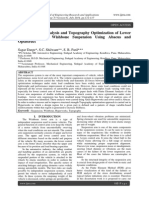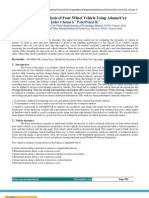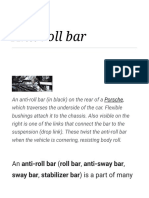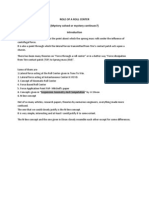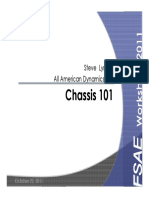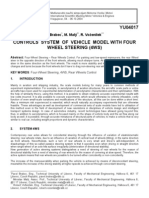0 ratings0% found this document useful (0 votes)
215 viewsAt2402 Notes
At2402 Notes
Uploaded by
Anonymous ETBwIduGiThis document contains notes from a lesson on vehicle dynamics. It discusses the objectives of studying vehicle vibrations and how to reduce them. It then outlines the topics covered in each of the 5 units:
Unit I introduces fundamentals of vibration including single, two, and multi-degree of freedom systems. It also discusses free, forced, and damped vibrations as well as models of automobiles.
Unit II covers stability of vehicles including load distribution and stability on turns, slopes, and banked roads.
Unit III examines multi-degree freedom systems including closed and far coupled systems, eigen problems, modal analysis, and forced vibration analysis.
Unit IV focuses on suspensions, tires, and vehicle handling
Copyright:
Attribution Non-Commercial (BY-NC)
Available Formats
Download as PDF, TXT or read online from Scribd
At2402 Notes
At2402 Notes
Uploaded by
Anonymous ETBwIduGi0 ratings0% found this document useful (0 votes)
215 views7 pagesThis document contains notes from a lesson on vehicle dynamics. It discusses the objectives of studying vehicle vibrations and how to reduce them. It then outlines the topics covered in each of the 5 units:
Unit I introduces fundamentals of vibration including single, two, and multi-degree of freedom systems. It also discusses free, forced, and damped vibrations as well as models of automobiles.
Unit II covers stability of vehicles including load distribution and stability on turns, slopes, and banked roads.
Unit III examines multi-degree freedom systems including closed and far coupled systems, eigen problems, modal analysis, and forced vibration analysis.
Unit IV focuses on suspensions, tires, and vehicle handling
Original Description:
hydraulics
Copyright
© Attribution Non-Commercial (BY-NC)
Available Formats
PDF, TXT or read online from Scribd
Share this document
Did you find this document useful?
Is this content inappropriate?
This document contains notes from a lesson on vehicle dynamics. It discusses the objectives of studying vehicle vibrations and how to reduce them. It then outlines the topics covered in each of the 5 units:
Unit I introduces fundamentals of vibration including single, two, and multi-degree of freedom systems. It also discusses free, forced, and damped vibrations as well as models of automobiles.
Unit II covers stability of vehicles including load distribution and stability on turns, slopes, and banked roads.
Unit III examines multi-degree freedom systems including closed and far coupled systems, eigen problems, modal analysis, and forced vibration analysis.
Unit IV focuses on suspensions, tires, and vehicle handling
Copyright:
Attribution Non-Commercial (BY-NC)
Available Formats
Download as PDF, TXT or read online from Scribd
Download as pdf or txt
0 ratings0% found this document useful (0 votes)
215 views7 pagesAt2402 Notes
At2402 Notes
Uploaded by
Anonymous ETBwIduGiThis document contains notes from a lesson on vehicle dynamics. It discusses the objectives of studying vehicle vibrations and how to reduce them. It then outlines the topics covered in each of the 5 units:
Unit I introduces fundamentals of vibration including single, two, and multi-degree of freedom systems. It also discusses free, forced, and damped vibrations as well as models of automobiles.
Unit II covers stability of vehicles including load distribution and stability on turns, slopes, and banked roads.
Unit III examines multi-degree freedom systems including closed and far coupled systems, eigen problems, modal analysis, and forced vibration analysis.
Unit IV focuses on suspensions, tires, and vehicle handling
Copyright:
Attribution Non-Commercial (BY-NC)
Available Formats
Download as PDF, TXT or read online from Scribd
Download as pdf or txt
You are on page 1of 7
Faculty Code: AU13
Faculty Name: RAJESH. M
Designation: LECTURER
Notes of Lesson
AU 2402 - VEHICLE DYNAMICS
OBJECTIVE
When the vehicle is at dynamic condition more vibration will be produced. It is essential to study about
vibrations and how to reduce the vibration under different loads, speed and road conditions in order to
improve the comfort for the passengers and life of the various components of the vehicle. In this subject
these aspects have been given.
UNIT- I INTRODUCTION 9
Fundamentals of vibration, single degree of freedom, two degree of freedom, multi-degree freedom, free,
forced and damped vibrations, modeling and simulation studies, model of an automobile, magnification
factor, transmissibility, vibration absorber.
UNIT- II STABILITY OF VEHICLES 9
Load distribution, calculation of acceleration, tractive effort and reactions for different drives, stability of
a vehicle on a curved track, slope and a banked road.
UNIT- III MULTI DEGREE FREEDOM SYSTEMS 9
Closed and far coupled system, eigen value problems, orthogonality of mode shapes, modal analysis,
forced vibration by matrix inversion.
UNIT- IV SUSPENSION, TYRES AND VEHICLE HANDLING 9
Requirements, sprung mass frequency, wheel hop, wheel wobble, wheel shimmy, choice of suspension
spring rate, calculation of effective spring rate, vehicle suspension in fore and aft, roll axis and vehicle
under the action of side forces, tyre, dynamics, ride characteristics power consumed by a tyre. Oversteer,
under steer, steady state cornering, effect of braking, driving torques on steering, effect of camber,
transient effects in cornering.
UNIT- V NUMERICAL METHODS 9
Approximate methods for determining fundamental frequency, Dunkerleys lower bound, Rayleighs upper
bound, Holzer method for closed coupled system and branched systems.
TOTAL: 45
TEXT BOOKS
1. Rao J.S and Gupta. K Theory and Practice of Mechanical Vibrations, Wiley Eastern Ltd., 2002.
2. Giri N.K Automotive Mechanics, Khanna Publishers, 2007.
REFERENCES
1. Ham B, Pacejka - Tyre and Vehicle Dynamics - SAE Publication - 2002.
2. Ellis.J.R - Vehicle Dynamics- Business Books Ltd., London- 1991
3. Gillespie T.D, Fundamentals of Vehicle Dynamics, SAE USA 1992.
4. Giles.J.G.Steering - Suspension and Tyres, Illiffe Books Ltd., London- 1998
UNIT I
INTRODUCTION
Fundamentals of vibration, single degree of freedom, two degree of freedom, multi-degree freedom, free,
forced and damped vibrations, modeling and simulation studies, model of an automobile, magnification
factor, transmissibility, vibration absorber.
Degree of freedom
The number of degree of freedom of a mechanical system is equal to the minimum number of
independent co-ordinates required to define completely the positions of all parts of the system at any
instance of time.
Multi degree of freedom
A multi degree of freedom system is one for which 2 or 3 co-ordinates are required to define completely
the positions of the system at any instance of time.
Free vibration
When there is no external force acts on the body after giving an initial displacement, then the body is said
to be under free or natural vibration.
Forced vibration
When the body vibrates under the influence of external force the body is said to be under forced
vibration. The frequency of forced vibration is called forced frequency.
Damped vibration
When there is reduction in amplitude over every cycle of vibration, the motion is said to be damped
vibration.
Magnification factor
It is the ratio between the maximum actual amplitude of the body and the maximum actual amplitude of
the road.
Transmissibility
It is the ratio between the force transmitted to the body and force acting on the road
Vibration absorber
Vibration absorber is an additional spring mass system used to make the amplitude values of vibration
equal to zero.
UNIT II
STABILITY OF VEHICLES
Load distribution, calculation of acceleration, tractive effort and reactions for different drives, stability of
a vehicle on a curved track, slope and a banked road.
For derivations and numerical, the students are advised
to refer Text Book 2
UNIT III
MULTI DEGREE FREEDOM SYSTEMS
Closed and far coupled system, eigen value problems, orthogonality of mode shapes, modal analysis,
forced vibration by matrix inversion.
The above figure represents a typical close couples system.
The above figure represents a typical far couples system.
EIGEN VALUE PROBLEMS
If a spring mass system is represented by matrices, the eigen value can be used to find the natural
frequencies of he system
ORTHOGONALITY OF MODE SHAPES
The mode shapes of a dynamic system exhibit orthogonality property, which is very useful in simplifying
the analysis for forced and transient vibrations.
MODAL ANALYSIS
When the degree of freedom of the system is large and / or when the forcing functions are non-periodic,
in such cases a more convenient method known as modal analysis can be used to solve the problem. In
this method, the expansion theorem is used, and the displacements of the masses are expressed as a
linear combination of the normal modes of the system.
UNIT IV
SUSPENSION, TYRES AND VEHICLE HANDLING
Requirements, sprung mass frequency, wheel hop, wheel wobble, wheel shimmy, choice of suspension
spring rate, calculation of effective spring rate, vehicle suspension in fore and aft, roll axis and vehicle
under the action of side forces, tyre, dynamics, ride characteristics power consumed by a tyre. Oversteer,
under steer, steady state cornering, effect of braking, driving torques on steering, effect of camber,
transient effects in cornering.
REQUIREMENTS OF A SUSPENSION SYSTEM
Stiffness/Displacement bound
Compatibility
Min wear
Maintenance low
Initial cost low
WHEEL HOP
It is the vertical oscillating motion of the wheel between the road surface and the spurng mass.
WHEEL WOBBLE
It is the horizontal vibration of front axle assembly around the longitudinal axis
STEADY STATE HANDLING CHARACTERISTICS OF A VEHICLE
Steady state handling characteristics is concerned with the directional behavior of a vehicle during a turn
under non-time varying conditions.
UNIT V
NUMERICAL METHODS
Approximate methods for determining fundamental frequency, Dunkerleys lower bound, Rayleighs upper
bound, Holzer method for closed coupled system and branched systems.
Students are required to understand different numerical
methods.
You might also like
- Guide to Load Analysis for Durability in Vehicle EngineeringFrom EverandGuide to Load Analysis for Durability in Vehicle EngineeringP. JohannessonRating: 4 out of 5 stars4/5 (1)
- Twist Beam DesignDocument38 pagesTwist Beam DesignSandeep KumarNo ratings yet
- Ackerman Erik ZapletalDocument23 pagesAckerman Erik ZapletalMrudula Amar WardeNo ratings yet
- FSAE SuspensionDocument37 pagesFSAE SuspensionDonald MuchemwaNo ratings yet
- Double WishboneDocument6 pagesDouble WishboneRian SteveNo ratings yet
- Active Control of Quarter Car Suspension System UsDocument10 pagesActive Control of Quarter Car Suspension System UsFaris HadiyantoNo ratings yet
- Effect of The Tire Lateral Force Saturation On Stability Control of 4WDEV SteeringDocument5 pagesEffect of The Tire Lateral Force Saturation On Stability Control of 4WDEV SteeringBerkay ÇelikNo ratings yet
- Suspension Analysis PDFDocument5 pagesSuspension Analysis PDFramsaiNo ratings yet
- Parametric Analysis of Four Wheel Vehicle Using Adams/Car: Jadav Chetan S. Patel Priyal RDocument6 pagesParametric Analysis of Four Wheel Vehicle Using Adams/Car: Jadav Chetan S. Patel Priyal RInternational Journal of computational Engineering research (IJCER)No ratings yet
- Study of Four Wheel Steering Mechanism: JournalDocument4 pagesStudy of Four Wheel Steering Mechanism: JournalSiva HariNo ratings yet
- Suspension Systems and ComponentsDocument90 pagesSuspension Systems and Componentsmaheshgarg81100% (2)
- Anti Roll BarDocument27 pagesAnti Roll BarU.S. DubeyNo ratings yet
- STEERING SYSTEM Design of An FSAE CarDocument7 pagesSTEERING SYSTEM Design of An FSAE CarPerepi HemanthiNo ratings yet
- Steering Report and CalculationsDocument8 pagesSteering Report and CalculationsVansh JainNo ratings yet
- Brake Report 2015Document38 pagesBrake Report 2015Pratyush NagareNo ratings yet
- Vehicle DynamicsDocument158 pagesVehicle Dynamicsadravid100% (3)
- Roll Center MysteryDocument7 pagesRoll Center MysteryMrudula Amar WardeNo ratings yet
- Theoretical Prediction and Experimental Substantiation of The Response of The Automobile To Steering ControlDocument25 pagesTheoretical Prediction and Experimental Substantiation of The Response of The Automobile To Steering ControlRTCN100% (1)
- Chassis 23 PDFDocument89 pagesChassis 23 PDFpartizan21No ratings yet
- Suspension Design by Ravi DeshmukhDocument11 pagesSuspension Design by Ravi DeshmukhsonirocksNo ratings yet
- 5.design of Modification and Improvement On Automobile Suspension SystemDocument31 pages5.design of Modification and Improvement On Automobile Suspension SystemSumithra NaikNo ratings yet
- Manual Double Barrel InstructionsDocument8 pagesManual Double Barrel InstructionsspankriderNo ratings yet
- Development and Experimental Verification of A Parametric Model of An Automotive DamperDocument126 pagesDevelopment and Experimental Verification of A Parametric Model of An Automotive DamperMrudula Amar WardeNo ratings yet
- Aerodynamics Related To ChassisDocument23 pagesAerodynamics Related To ChassisAmal MechanicNo ratings yet
- Vehicle Dynamics ProDocument15 pagesVehicle Dynamics ProChirag D PatelNo ratings yet
- Team Teaching Presentation How Car Suspension WorksDocument17 pagesTeam Teaching Presentation How Car Suspension Worksmsaad19103564No ratings yet
- Automatic Air Suspension SystemDocument17 pagesAutomatic Air Suspension Systemmonikaneha123100% (1)
- VD PPT Unit IIDocument71 pagesVD PPT Unit IIpawarsiddharth0311No ratings yet
- MFeval v1.4Document23 pagesMFeval v1.4f20202281No ratings yet
- Ackerman Vs Anti - Ackerman: Load On It While Cornering Load On It While CorneringDocument1 pageAckerman Vs Anti - Ackerman: Load On It While Cornering Load On It While CorneringjohncenaNo ratings yet
- Suspension Control SystemsDocument39 pagesSuspension Control SystemsKRISHNAPRIYANo ratings yet
- RequestDocument22 pagesRequestOmar MuñozNo ratings yet
- Seminar Presentation On Aerodynamics of F1 by 1609069Document8 pagesSeminar Presentation On Aerodynamics of F1 by 1609069dimpu reincarnatedNo ratings yet
- Torsen Differential White PaperDocument8 pagesTorsen Differential White PaperPadmAnabhNo ratings yet
- Baja SAE Auburn Design Report Cleveland State University 16Document10 pagesBaja SAE Auburn Design Report Cleveland State University 16Noel Mahung Melendez100% (1)
- Bump SteerDocument5 pagesBump SteerHimanshu Rajput100% (2)
- DamperDocument52 pagesDampergnaniofs3960No ratings yet
- Worksheet For Finding Tyre RateDocument1 pageWorksheet For Finding Tyre RatePrasadHd100% (1)
- Transmission 1Document42 pagesTransmission 1dhavalNo ratings yet
- Pacejka 2002 WebPageDocument49 pagesPacejka 2002 WebPagetrisinoNo ratings yet
- Camber AnglesDocument8 pagesCamber AnglesAbhishek Sharma100% (2)
- Bma4723 Vehicle Dynamics Chap 5Document31 pagesBma4723 Vehicle Dynamics Chap 5Fu HongNo ratings yet
- Design & Analysis of Steering System For Solar VehicleDocument4 pagesDesign & Analysis of Steering System For Solar VehicleYesh100% (1)
- Kinematic and Dynamic Analysis of Independent Suspension SystemDocument9 pagesKinematic and Dynamic Analysis of Independent Suspension Systemsiddhartha180987100% (3)
- 07 1 Suspension ConceptsDocument26 pages07 1 Suspension ConceptspankajNo ratings yet
- Chapter 6 - Suspension SystemDocument13 pagesChapter 6 - Suspension SystemLalith Koushik Ganganapalli100% (1)
- Optimization of Suspension DesignDocument9 pagesOptimization of Suspension Designmult69No ratings yet
- Vehicle Dynamics Lecture05Document28 pagesVehicle Dynamics Lecture05Rahul KadbeNo ratings yet
- Spring Rates Roll Centers and HandlingDocument9 pagesSpring Rates Roll Centers and HandlingfizznitNo ratings yet
- Vehicle DynamicsDocument6 pagesVehicle DynamicsypkalariyaNo ratings yet
- Four Wheel Steering SystemDocument7 pagesFour Wheel Steering SystemAmar Jeet100% (1)
- Vehicle Chassis Designs (Various Types of Vehicle Structures)Document5 pagesVehicle Chassis Designs (Various Types of Vehicle Structures)Muhammad AsifNo ratings yet
- High Speed Off-Road Vehicles: Suspensions, Tracks, Wheels and DynamicsFrom EverandHigh Speed Off-Road Vehicles: Suspensions, Tracks, Wheels and DynamicsNo ratings yet
- CirclesFormualaSheetlyx PDFDocument5 pagesCirclesFormualaSheetlyx PDFAnonymous ETBwIduGiNo ratings yet
- CAEA v145 Update CFDDocument39 pagesCAEA v145 Update CFDAnonymous ETBwIduGiNo ratings yet
- 1.lesson Plan AtdDocument3 pages1.lesson Plan AtdAnonymous ETBwIduGiNo ratings yet
- Selection Guide To Aluminum Sheet and Plate (Ref. ASTM-B209)Document2 pagesSelection Guide To Aluminum Sheet and Plate (Ref. ASTM-B209)Lữ Hành ShutoNo ratings yet
- TrussesDocument18 pagesTrussesVivek SrivastavaNo ratings yet
- Process Planning & Cost Estimation Question BankDocument12 pagesProcess Planning & Cost Estimation Question Banksanbharani4242100% (2)
- Engineering Drawings: The Blank Engineering Drawing FormDocument16 pagesEngineering Drawings: The Blank Engineering Drawing Formadnan100% (1)
- Nuclear EngineeringDocument2 pagesNuclear EngineeringAnonymous ETBwIduGiNo ratings yet
- Micro LiquidDocument5 pagesMicro LiquidAnonymous ETBwIduGiNo ratings yet





